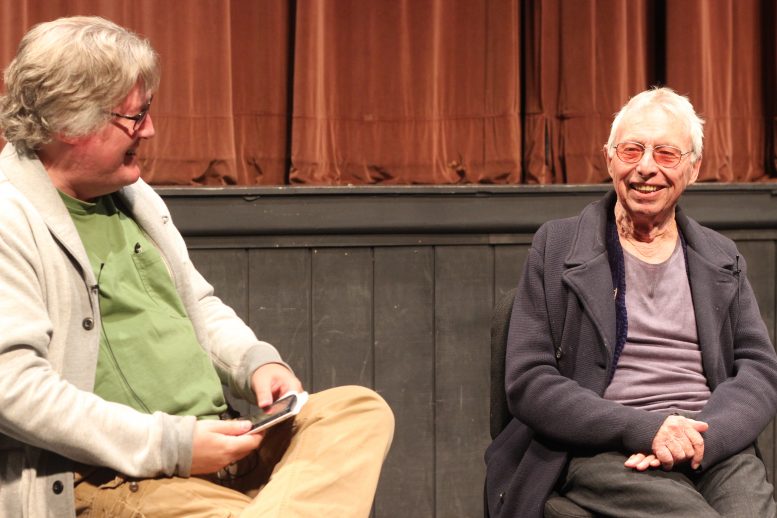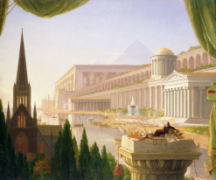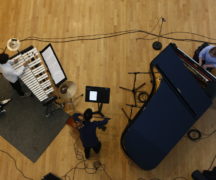By DAVID DUPONT
BG Independent News
Composer Harold Budd is a humble sort of icon.
During his visit to Northwest Ohio, he was surrounded by fans.
When Scott Boberg of the Toledo Museum of Art, asked those gathered Saturday night in the Peristyle to hear his pre-concert talk, how many owned more than five Budd albums, scores of hands went up.
And not the least of those fans was Boberg himself, who coordinated the visit. He knew exactly where and when as a teenager he purchased his copy of Budd’s seminal work, “Pavilion of Dreams.”
Kurt Doles, the director of the MidAmerican Center for Contemporary Music at Bowling Green State University, also started to listen to the California composer’s work in his teens.
In a telephone interview with BG Independent, and then in public conversations with Boberg and Doles at separate events, Budd leaves the impression that they listen to his music far more than he does.
When asked at BGSU about the state of music and what it bodes for the future, Budd allowed he doesn’t really listen to much music.
Asked about issues of his own compositions — how he develops his music from titles, or the music’s relationship painting, or how pieces grow from improvisations — he didn’t elaborate much.
Talking about improvisation, he said: “What you hear is what I ended up getting. I didn’t plan on it.”
Still, he said, it is what he “intended,” and then “I worked hard at it.”
At the Peristyle on Saturday, he premiered a new piece, “Petits Souffles.” He was asked before the performance what inspired it.
Well, he explained, his companion, an artist, was busy painting, upstairs in the home in the Mojave Desert where they were staying.
Downstairs “I was just sitting on my ass,” he said. So he decided to compose the piece. It was inspired mostly by 20th century paintings he admired, created by artists too little admired by others. Then for the final movement, he turned to a contemporary American artist.
In a telephone interview with BG Independent, he said: “It doesn’t fit with my initial idea. Big deal. Just do it.”
This was a beloved composer who during conversation with Doles at BGSU referred to himself as an idiot, a chump, a snob, and “the boringest man in the world.”
Yet this comes across not as someone who doesn’t take himself seriously but as a deep seriousness that can’t accommodate itself to puffery. He speaks softly and doesn’t have much of a schtick.
Budd, 82, started off his musical life as a percussionist. Growing up in Los Angeles during World War II, he witnessed many military parades. He was taken by the Scottish drummers.
So he took percussion lessons and learned his rudiments. His great musical epiphany came when as a teenager he heard the bebop of Charlie Parker and his jazz contemporaries.
“What I really wanted to be was Max Roach,” he said, referencing Parker’s long-time drummer. “But I didn’t have that kind of skill.” He still reveres bebop, but “I can’t play it, and I can’t listen to it.”
Later he was living in an African-American neighborhood, and he went to a bar that featured the band of pianist Paul Bley — his sidemen would all become legends, Ornette Coleman, saxophone, Don Cherry, cornet, Billy Higgins, drums, and Charlie Haden, bass. That band, without Bley, would go on to revolutionize jazz as pioneers of free jazz.
Here was a new music that captivated Budd. “I got it immediately,” he said.”I knew what to do and how to do it.”
Later Budd was in the Army with another free jazz legend, Albert Ayler. The two jammed together and were close enough that Budd considered re-enlisting so they could stay together.
Then Budd discovered the work of artist Mark Rothko and his fellow color field painters. Though he only saw their work reproduced in a book, he understood the power of the large canvasses. These images came to shape the music that Boberg, Doles, and others fell in love with.
Budd came to academic studies late.
He worked in an aircraft factory and labored at other jobs. “I put myself through a lot of torture, many really crap jobs,” he said. “This is my life and it’s going to be this way for me unless I do something about it.”
So he went to school intending to be an artist and filmmaker before a class in counterpoint led him to music.
He ended up teaching at California Institute of the Arts. He became disillusioned. “The art coming out of the school was awful,” he said. Everything was about performance art. “Painting didn’t exist.”
His was out of synch with what he was exploring musically.
“I was employed and had children,” he said. “It was not bad being a professor. Much better than starvation.”
It was another free jazz figure and collaborator Marion Brown who persuaded him to quit and forge his own path.
Then one day Brian Eno, formerly of Roxy Music, gave him a call. He’d heard one of Budd’s “Madrigals of the Rose Angel” performed and wanted to record it. So Budd headed to England to record for Eno’s Obscure label. Since then Budd has often collaborated with other artists, and YouTube is rich with recordings of this work, all of it with a meditative lushness, full of sensuous sounds that slowly evolve.
On Saturday night, Budd in a rare event took part in a performance of his music, including early pieces, some from earlier this century, and concluding with a couple premieres —“Petits Souffles” and “Desert Train Whistles and Billy’s Dracula.”
This last piece, he said, was composed because he felt the Toledo program as planned was too short and needed something more.
The program began with one of Budd’s “Lirio,” a solo for gong from 1971. He composed in a bar in Guadalajara, Mexico. There was a story in how he came to be there, he said, but he demurred.
No, the gong composition was not a way of starting the concert off with a bang. Quite the opposite. Percussionist Sean Connors rolled his way slowly, quietly, methodically around every inch of the gong’s surface. The waves of sound rolled over the audience. The tones changed depending on where on the gong the mallets struck. As the notes reverberated, they created harmonies, sometimes dissonant.
Most of the concert was devoted to music for string quartet, with and without Budd on keyboards. The TSOMA Ensemble — Merwin Siu and Cheryl Trace, violins, Kalindi Bellach, viola, and Brian Snow, cello — with the composer on grand piano performed Budd’s 1970 work “Candy Apple Vision.”
Throughout the concert string sound was transparent, spectral, stripped to the bone. Everything seemed in slow motion and rooted in the middle range of the instruments. When a violin burst into a higher register, it was a shock.
This was music that explored the boundary between silence and sound. The spareness pulled the audience in, joining them in the concentrated exercise of listening intently.
Budd returned for “Petits Souffles” for string quartet and celeste. As the strings whispered, Budd added spare, ringing commentary.
Even the addition of the chimes, played by Dan Piccolo, on the final piece, the encore premiere, “Desert Train Whistles and Billy’s Dracula,” didn’t much change the volume. It blended with Budd playing Fender-Rhodes electric piano, and Bellach’s viola. Budd told the BGSU audience that he wrote it because he thought the electric piano and chimes would blend well. “I want to hear that so much,” he said. “If you see my face drop, you’ll know Harold’s messed up again.” His face didn’t drop. He smiled.
This piece was one of two on the program dedicated to the artist Billy Al Bengston, whom Budd said was his favorite contemporary painter.
Budd’s love of art was the lure that brought him to Toledo. After being approached with the idea for the residency, Budd’s manager traveled to Toledo to visit the museum. He told Budd, who had never visited Ohio before, that the museum was well worth seeing.
Saturday, having spent three days in Toledo, he agreed with that assessment. He’d be sorry to leave Toledo, he said. “This is a totally bitchin’ city.”





